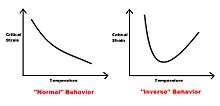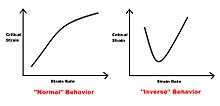Portevin–Le Chatelier effect
The Portevin–Le Chatelier effect (PLC) describes a serrated stress-strain curve or jerky flow, which some materials exhibit as they undergo plastic deformation, specifically inhomogeneous deformation.[1] This effect has been long associated with dynamic strain aging or the competition between diffusing solutes pinning dislocations and dislocation breaking free of this stoppage.[2]
The onset of the PLC effect appears when the strain rate sensitivity becomes negative and inhomogeneous deformation starts.[1] This effect also can appear on the specimens surface and bands of plastic deformation. This process starts at a so-called critical strain, which is the minimum strain needed for the onset of the serrations in the stress-strain curve. The critical strain is both temperature and strain rate dependent.[2] The existence of some critical stain are attributed to better solute diffusivity due to the deformation created vacancies and increased mobile dislocation density. Both of which contribute to the instability in the substitutional alloys, while interstitial alloys are only effect by the increase in mobile dislocation densities.[3]
Conditions that affect the PLC effect
Temperature
Temperature affects both the speed of band propagation through the material and the critical strain. The speed of band propagation is proportional to the temperature (lower temp lower speeds, higher temp higher speeds). Often time the critical stain will first decrease due to temperature.[2] The temperature effect on PLC regime is causes by the increased ability of the solutes to diffuse to the dislocations with increasing temperature. Although the mechanism of diffusion is not entirely defined, it is believed that solute atoms diffuse by either volume (high temperatures), diffusion in stacking fault ribbon between partial dislocations (intermediate) or pipe diffusion(low temperature).[3]
Strain rate
While temperature related to rate of diffusion, strain rate determines the time that the dislocations take to overcome these obstacles and have a dramatic effect on the conditions of the PLC effect. So generally the critical stress will decrease with imposed strain rate.[3] Also the higher stress rate the lower the band speed [2]
Precipitates
Often found in Al alloys (especially of the Mg variety) precipitates complicate the PLC effect.

Often these precipitates will cause the so-called inverse behavior which changes the effect of both strain rate and temperature on the solid [4] The Presence of precipitates is shown to have influence on the appearance and disappearance of serrations in the stress strain curve

Grain size
The structure of the material as well has an effect on the appearance and parameters that describe the PLC effect. For example the magnitude of the stress drops is larger with smaller grain. The critical strain often increases with larger grains which is linked to the dependence of the dislocation density to grain sizes [5] Serration amplitude was greater in Al-Mg alloys for finer grain size. There is a correlation between increasing the critical stain and the onset of serration with increasing grain size.[6] But some findings indicate that the grain size has practically no effect on the band velocity or the band width.[3]
Material finish
Polishing the material affects the beginning of the PLC effect and the band velocities that were reported. Apparently a rougher surface provides more nucleation points causing stress raiser which help initiate deformation bands. These bands also propagate twice as fast in the polished specimen [2]
Non effects
The number of vacancies does not directly affect the PLC start point. It was found if a material is pre-strained to a value ½ of that required to initiate jerky flow and then rested at the test temperature or annealed to remove vacancies (but low enough that the dislocation structure is not affected), the total critical strain is only slightly decreased as well as the types of serrations that do occur.[7]
Serrations descriptors
While properties like strain rate sensitivity and critical strain mark the beginning of the PLC effect, people have developed a system to describe the serrations themselves. These types are often dependent on strain rate, temperature, and grain size.[5] While usually the bands are labeled A, B, and C some sources have added a D and E type Bands.[8] Because the type A, B, and C type bands are most found in literature they will be the only ones covered here.

Type A bands
Type A bands are often seen at high strain rate and low temperatures.[8] They are a random development of bands that form over the entire specimen.[9] They are usually described as continuously propagating with small stress drops.[3]
Type B bands
Type B bands are sometimes described as “hopping” bands and they appear at a medium to high strain rates.[9] They are often seen as each band forming ahead of the previous one in a spatially correlated way. The serrations are more irregular with smaller amplitudes than type C.[3]
Type C bands
C bands are often seen at low applied strain rate or high temperatures.[8] These are identified with random nucleated static bands with large characteristic stress drops the serration.[3]
Other notes on band types
The different types of bands are believed to represent different states of dislocation in the bands, and band types can change in a materials stress strain curve. Currently there are no models that can capture the change in band types [3]
Portevin-Le Chatelier (PLC) effect is a proof of non-uniform deformation of CuNi25 commercial alloys at intermediate temperature. In CuNi25 alloy it manifests itself as irregularities in the form of serrations on the stress-strain curve. It proves instability of force during tension and heterogeneity of microstructure and presence of many heterogeneous factors, affecting its mechanical properties.[10]
Problems caused by the PLC effect
Because the PLC effect is related to a strengthening mechanism, the strength of steel may increase; however, the plasticity and ductility of a material afflicted by the PLC effect decrease drastically. The PLC effect is known to induce blue brittleness in steel; additionally, the loss of ductility may cause rough surfaces to develop during deformation (Al-Mg alloys are especially susceptible to this), rendering them useless for autobody or casting applications.[2]
References
- 1 2 Van Den Beukel, A. (1975)“Theory of the effect of Dynamic Strain Aging on Mechanical Properties” Phys. Stat. Sol. (a) 30, 197
- 1 2 3 4 5 6 Abbadi, M., Hahner, P., Zeghloul, A.(2002) “On the characteristic of Portevin-Le Chatelier band in aluminum alloy 5182 under stress controlled and strain- controlled tensile testing” Materials Science and Engineering A337: 194-201
- 1 2 3 4 5 6 7 8 Ananthakrishna, G. (2007)“Current theoretical approaches to collective behavior of dislocations”, Physics Reports 440:113-259
- ↑ Brechet, Y., Estrin, Y.,(2006) “On the influence of precipitation of the Portevin-Le Charelier Effect” Acta Metall. Mater. Vol. 43:955-964
- 1 2 3 Mannan, S.L.(December 1993) “Role of dynamic stain aging on low cycle fatigue.” Material Science vol 16 no 5
- ↑ Van Den Beukel, A. and Kocks, U.F.(1982) “The strain dependence of static and dynamic strain aging” Acta Metall. Vol. 30
- ↑ Mulford, R.A. and Kocks, U.F., "New Observations on the Mechanism of Dynamic Strain Aging and of jerky Flow” Acta Metallurgica Vol 27
- 1 2 3 Rodriguez, P.(September 1984) “Serrated Plastic flow.” Bull. Material Sci. Vol. 6 no 4
- 1 2 Bruggemann, C., Bohlke, T, Bertram, A. (2008) “Modeling and simulation of the Portevin Le Chatelier Effect” Micro-Macro-Interactions: In Structured Media and Particle SystemsBerlin: Springer-Verlag:53-62
- ↑ Sakiewicz P.,Nowosielski R., Babilas R. Production aspects of inhomogeneous hot deformation in as-cast CuNi25 alloy, Indian Journal of Engineering & Materials Sciences, Vol. 22, August 2015, pp. 389-398